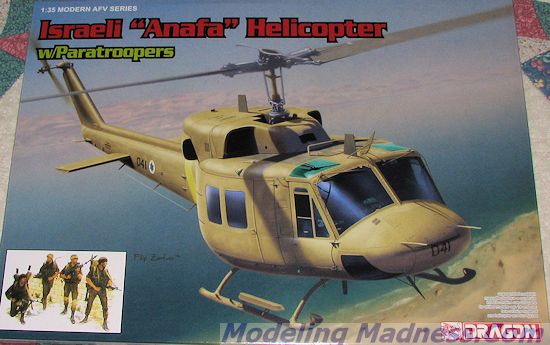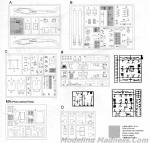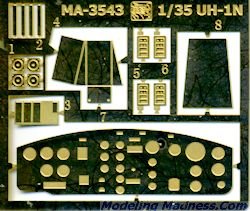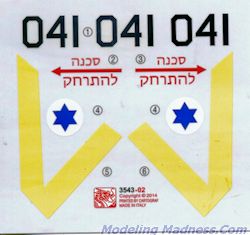
| KIT #: | 3543 |
| PRICE: | $64.00 SRP |
| DECALS: | options |
| REVIEWER: | Scott Van Aken |
| NOTES: | Modern AFV series |

| HISTORY |
Based on the stretched fuselage Bell 205, the Bell 212 was originally developed for the Canadian Forces (CF) under the designation CUH-1N Twin Huey. Later the CF adopted a new designation system and the aircraft was re-designated as the CH-135 Twin Huey. The CF approved the development of the aircraft on 1 May 1968[1] and purchased 50 aircraft, with deliveries commencing in May 1971.
The US military came very close to not procuring the Twin Huey. The purchase of the aircraft for US military use was opposed by the Chairman of the House Armed Services Committee at the time, L. Mendel Rivers. Rivers took this position because the aircraft powerplant, the Pratt & Whitney Canada PT6T was produced in Canada. The Liberal Canadian government of the time had not supported US involvement in Vietnam and had opposed US policies in southeast Asia, as well as accepting US draft dodgers. Rivers was also concerned that procurement of the engines would result in a negative trade deficit situation with Canada. Congress only approved the purchase when it was assured that a US source would be found for the PT6T/T400 engines. As a result the United States military services ordered 294 Bell 212s under the designation UH-1N, with deliveries commencing in 1970.
Unlike in the Canadian Forces, in US service, the UH-1N retained the official name "Iroquois" from the single engined UH-1 variants, although US service personnel refer to the aircraft as a "Huey" or "Twin Huey".
The Bell 412 is a further development of the Bell 212, the major difference being the composite four-blade main rotor. The UH-1N has also been developed into the upgraded, four-blade UH-1Y.
The UH-1N was subsequently sold to dozens of foreign military air arms, including Israel. Hundreds are still operational and in daily use world-wide.
| THE KIT |
 I stated in an earlier UH-1N article that I thought this kit was basically a reboxing of the Panda kit and so far, no one has refuted that so I guess it is true. The kit has nicely done engraved panel line and the now standard rivet detail where appropriate. is kit has engraved panel lines and nicely done raised rivet detail as well. In all, I think it represents the aircraft rather well.
I stated in an earlier UH-1N article that I thought this kit was basically a reboxing of the Panda kit and so far, no one has refuted that so I guess it is true. The kit has nicely done engraved panel line and the now standard rivet detail where appropriate. is kit has engraved panel lines and nicely done raised rivet detail as well. In all, I think it represents the aircraft rather well.
 This boxing is basically an excuse to move an old figure set, #3001 for Israeli paratroopers. Though the figures are not new, they are still very nicely molded and a nice addition. The previous kits had a rather extensive photo etch suite that included color photo etch. Those who are not fond of the material will be pleased to know that this one is greatly reduced. The set is for the main instrument panel (no dial detail, though), foot pedals, a wedge shaped box that fit on the side of the instrument console, and a couple of other small cockpit bits.
This boxing is basically an excuse to move an old figure set, #3001 for Israeli paratroopers. Though the figures are not new, they are still very nicely molded and a nice addition. The previous kits had a rather extensive photo etch suite that included color photo etch. Those who are not fond of the material will be pleased to know that this one is greatly reduced. The set is for the main instrument panel (no dial detail, though), foot pedals, a wedge shaped box that fit on the side of the instrument console, and a couple of other small cockpit bits.
The cockpit is very nicely done and the seats have nicely done molded on seat harness detail. As you would expect in this scale, both the collective and cyclic are included. The cabin has canvas seats just behind the cockpit and there is a quilted texture to the rear bulkhead and the cabin overhead. A nicely detailed rotorhead is included that fit on the other side of the overhead.
Cockpit side windows fit from the inside as do the ones for just above the seats (which will need to be painted clear green prior to installation). For the upper engine compartment, there are optional side panels, one set which has large access doors compared to the other. There are weapons pylons for the rockets. Another optional panel for the t ail boom is provided, one of which has an access door. There is no indication on these panels as to which is correct for this version.
ail boom is provided, one of which has an access door. There is no indication on these panels as to which is correct for this version.
here are separate cabin entrance doors which are designed to be slid open or closed. HF antenna masts are also included. The modeler will need to wire this feature. Both the main and tail rotor are designed to be moved.
Instructions are well done in 10 clearly drawn construction steps. Gunze paint references are provided throughout the build process. The back of the instructions as an assembly and painting guide for the four figures. Markings are provided for a single aircraft with the Israeli Air Force.
| CONCLUSIONS |
This is not a super complex kit and with a parts count of about 200 including the figures, should be a kit that anyone with moderate skill should be able to handle. Some will bemoan the simpler p.e. fret while others will appreciate not having to deal with hundreds of small parts. Those who'd rather do another set of markings will not have much difficulty finding options and there is a goodly bit of aftermarket available for this kit.
| REFERENCES |
http://en.wikipedia.org/wiki/Bell_UH-1N_Twin_Huey
September 2014 Thanks towww.dragonmodelsusa.com for the preview kit. You can get yours at your local hobby shop or on-line retailer. If you would like your product reviewed fairly and fairly quickly, please contact the editor or see other details in the